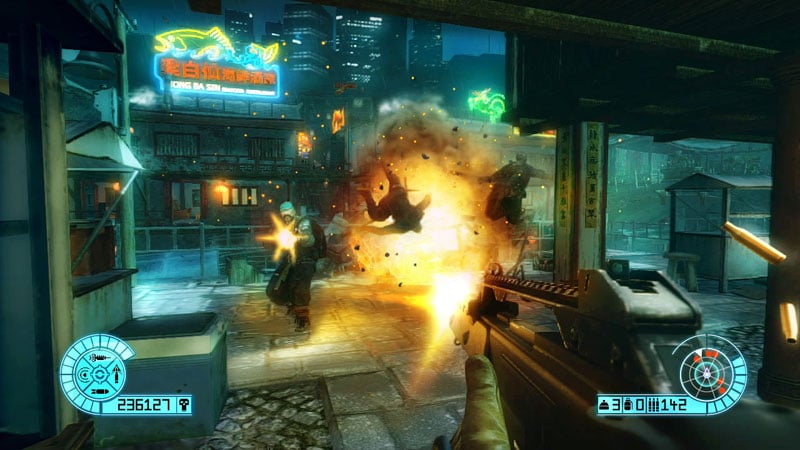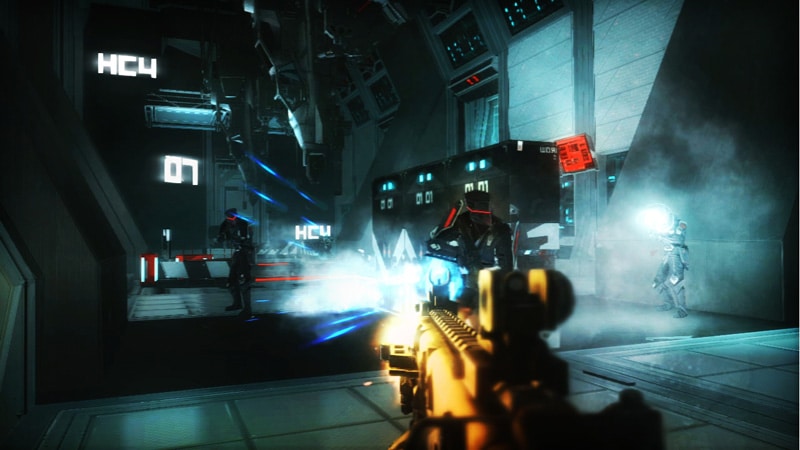In what has turned out to be the best console generation in terms of sales for shooters, it’s not surprising that publishers who have traditionally stayed away from the genre are trying to get their feet wet. What does boggle the mind though is how a publisher can afford or justify pushing out a game as consistently abysmal as Bodycount on to such a competitive playing field.
At its heart, Bodycount is a traditional arcade shooter beefed up with the trappings expected from a modern day game. You play a mercenary employed by an organization called ‘Network’, whose business motto appears to be shooting the crap out of locations in developing countries. The usual shooter checklist is accounted for – two guns, two types of grenades and a knife. There are a couple of twists in the form of the iron sights mechanic and the special abilities. The iron sights works in two ways depending on how far you press down on the left trigger. A half press and you can aim and move just like any other modern day shooter. A full press yields a new mechanism whereby you are rooted to the spot and can use the movement stick to dodge bullets by moving your character’s torso left and right. Sounds like a nice twist in theory, but in practice, it is a broken system since there is little point in dodging bullets and its extremely difficult to maintain the trigger at the halfway mark in the heat of battle, meaning you find yourself stuck in place, leaning from side to side when you really want to be hauling ass.

There are four special abilities that get unlocked as you progress through the game. One grants you extra speed and invulnerability, another gives you extra bullet damage, a third grants you an airstrike ability, and the last one provides you with enemy detection and some sort of anti-human EMP power. These abilities are powered by ‘Intel’, which are pickups that sprout from wounded or dead enemies. The speed + invulnerability is the only really useful ability, while the rest are mostly fluff that has little impact on the situation or can only be used in specific circumstances.
For a game that promotes itself as a shooting experience, the gunplay is a huge letdown. The weapon selection is weak at first, with only a couple of genuinely useful and fun guns being unlocked towards the end of the game. Aiming is wonky thanks to laggy controller response. Enemies do not react the way you’d expect when shot, with some not bothering to react at all, while others behave like hopped up ragdolls. Grenade throws rarely ever travel where you want them to, often ending up right at your feet after bouncing off some unknown environmental obstacle. You think that matters can’t possibly get worse till you try to knife an enemy. The knifing animation is laughable and its effect on the enemy even more absurd, with a rare one-hit kill in between a spate of bizarre knifing animation jousts between your character and the enemy that you almost always lose.

Enemy AI is absolutely horrendous. Grunts will often run in bizarre paths right past you and take up position in areas of the map you have already cleared. Most of them are extremely happy to run right into you while you pump them full of lead and pray that the hit detection and hit damage algorithms catch up. For all their bizarre behaviour, the enemies have laser like precision with their grenade throws, a fact which aggravates your frustration at the game’s mockery of your own grenade tossing efforts. There are the standard variety of grunts, snipers and heavies with passably different skin textures depending on which of the game’s two developing countries you are currently fighting your way through. There is a third enemy group that belongs to ‘Target’, a rival organization. Their design and costumes appears to have been inspired by someone’s vision of Nazi forces from the 25th century.
Compounding the comedy of errors are the bland and recycled level design, nonsensical story and utterly pitiful graphics. The plot actually makes less sense the more you try to follow it and doesn’t even bother trying to justify why you are shuffled from place to place and why you are doing what you do. The visuals, (under)powered by Codemasters EGO graphics engine, have zero trace of the graphical beauty witnessed in Dirt and Grid, except for the main menus. Instead, we are presented with PS2 era visuals (and not the nice kind either) with horrible frame rates whenever the action gets heavy, which is pretty much all the time. The frame rates get so bad at times that the game fails to respond to your controller inputs, so reloading your weapon takes several pushes of the reload button.
The monotonous action sequences are punctuated by cheap sets with atrocious difficulty spikes, where you are trapped in tight, closed areas and have to face wave after wave of enemies. These situations are where another flaw in the game gets highlighted – the poor checkpointing system. And to say the boss fights are uninspired would be too generous. Multiplayer, at least on PSN, was a graveyard during my time with the game. The standard variety of game modes are present, but good luck finding many people to play with.
Conclusion
Bodycount reeks of laziness, is devoid of ideas, is completely unpolished and not worth your money. It should never have been allowed to leave George Romero’s Daikatana Sequel Ideas bin.